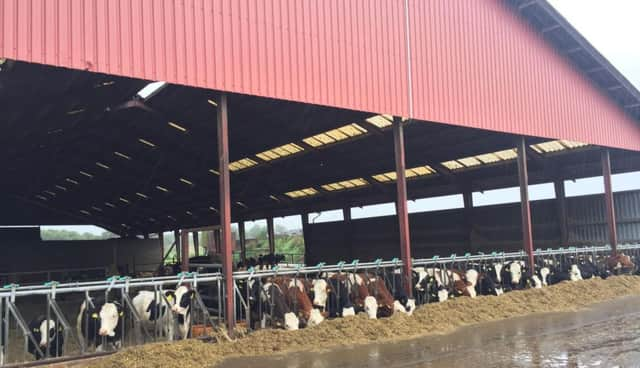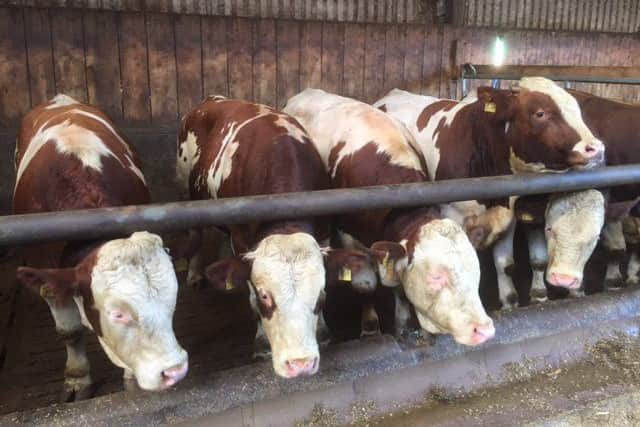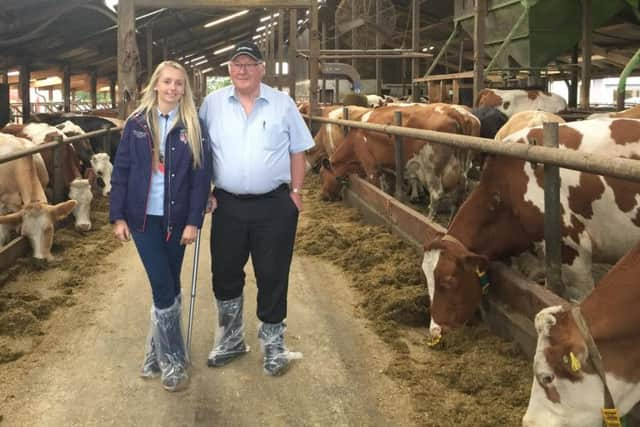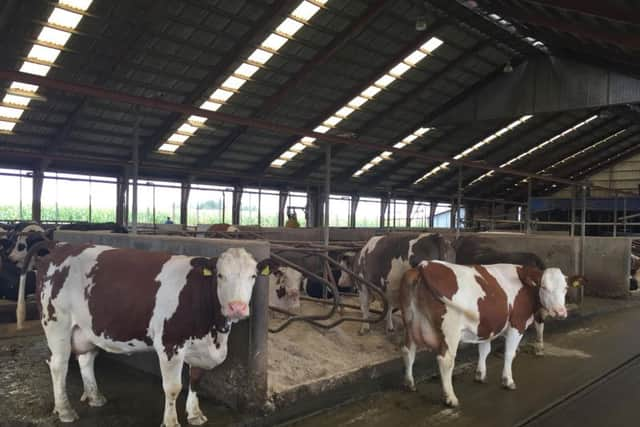Three-day Fleckvieh trip visits Danish and German farms


It was a very enjoyable trip, with the converted Fleckvieh enthusiasts even more convinced they are on the right route to achieving their breeding goals. For the more skeptical visitors, the trip certainly provided a lot of food for thought.
During our time away we visited two Danish farms and two German farms. On comparison the two Danish farmers were professional at managing their dairy herds which were the main enterprises on both farms. The German farms both operated dairy herds alongside other enterprises such as bull beef and tillage contracting.
Advertisement
Advertisement
Bayern Genetik operates the largest Fleckvieh stud in Europe. First stop was the company’s Export Centre at Sprillbek in the Schleswig-Holstein area of Germany. Visitors were given a tour of the facilities and inspected two lorries full of in-calf Fleckvieh heifers which were embarking on a lengthy journey to Turkey. The heifers, including delivery, were costing 2,300 Euro each.


The hospitality was excellent, with the 48-strong group having the opportunity to taste local beers and a traditional barbecue.
The next day the group visited the 180-cow herd owned by Petro and Ellen Pelgrum at Struer in Denmark. They moved from Holland 20 years ago, and their farm comprises of 112 hectares which is divided into 55ha maize and 10ha grain with the remainder in grass. The herd’s average yield is 11,200kgs at 4.27% butterfat and 3.55% protein, with SCC 130.
Ten years ago the Pelgrum family changed from Holstein to Fleckvieh in order to improve feet and leg problems and digestive upsets within the herd. Here the group was introduced to a new feeding method called compact feeding. The process involves steeping concentrates in water overnight before mixing with silage in a vertical wagon. This change to the feeding regime has resulted in an increase of two litres of milk per cow per day.
Advertisement
Advertisement
The herd has a calving interval of 365 days, with heifers calving into the herd at 25 months-old. Bull calves fetch €200 at ten-days-old. Cull cows average €1,200. The herd’s replacement rate is 25% which is lower than the 38% Danish average. Antibiotics or teat sealants are not used at drying off.


Everyone remarked how content the cows were, with the majority of the herd lying in the deep sand bed cubicles. Petro explained that a recent trial had revealed the cows were lying for 14 hours in a 24 hour period. The expected average is nine to ten hours.
Second visit of the day was the 430-cow herd owned by Bennie and Gerda Nijhuis. Three-quarters of the herd are Fleckvieh cross Holstein. They are milked three times per day and the average yield is 11,700kgs.
The Nijhuis family moved from Holland to Denmark 25 years ago. They started out with 48 cows, and moved to their present farm ten years ago. In 2013 Bennie introduced compact feeding, resulting in an extra 3kgs of milk per cow per day.
Advertisement
Advertisement
Cows are averaging 35kgs of milk per day, with the top cows in the herd producing 70kgs. Mr Nijhuis commented: “I love to work with strong trouble-free cows giving lots of milk. Cross breeding has improved fertility and this has increased our profit.”


Total production costs on the farm are 29 Euro cent per kilo, and the current price received for milk is 34 cents. Bull calves realise between €250 and €300 at four-weeks-old, while cull cows fetch €1,200.
In Denmark the average borrowing is €20,000 per cow, so herd owners have to focus on profitability to keep the banks happy. Five years ago the bank halved the value of land they would fund, as it wasn’t realistic trying to pay loans at the previous exorbitant prices.
The next day the first stop was Jorg Stroh’s 120-cow herd, comprising of purebred Fleckvieh cows, and half and three-quarter bred Fleckvieh cross red and white dual-purpose Holsteins.
Advertisement
Advertisement
The cows are mated with Fleckvieh stock bulls. Mr Stroh has a 9,000kgs herd average at 4.30% butterfat and 3.40% protein, and the milk price is 34 cents per kilo.


The benefits of using proven AI sires compared to stock bulls was emphasised on this farm. Everyone remarked on the non-uniformity of the herd, and the variable udder quality, as well as the poor legs and feet.
Fourth and final visit on the itinerary was Jan Schulldorf’s farm which included 150 pure Fleckvieh and Fleckvieh x red and white dual purpose Holsteins. He has been using Fleckvieh for ten years, and the herd average is 8,300kgs at 4.20% butterfat and 3.70% protein.
Heifers calve into the herd at thirty-months-old. The group also had an opportunity to see the farm’s bull beef enterprise. This was very impressive and included 130 fattening bulls of various ages, ranging from calves to slaughter-weight animals at 22 months-old. All bulls are born on the farm, apart from the purchased stock bulls.
Advertisement
Advertisement
Finished bulls are achieving carcase weights of 450kgs, and this coupled with bonuses, equates to almost €2,000 per head. A very tight culling policy is in place as cull cows fetch €3.20 per kilo. Milk base price is 34 Euro cents per kilo, with this farm achieving 39 Euro cents for quality.
To find out more about the wide range of proven dual-purpose Fleckvieh genetics available from Bayern Genetik contact David Hazelton tel: 07841 748764.